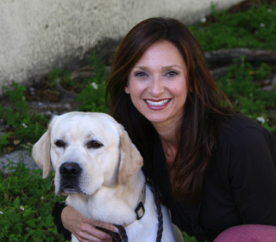
Dr. Lisa Radosta, Board Certified Veterinary Behaviorist, Discusses Separation Anxiety In Our Pets!
Hi Everyone! I could not be more excited to introduce our guest blogger this week, Dr. Lisa Radosta, a Board Certified Veterinary Behaviorist. Unfortunately, separation anxiety in pets is extremely common and something I see frequently at my animal hospital. Separation anxiety is difficult for me, my clients, and most importantly, my patients. Dr. Lisa Radosta specializes in behavioral disorders and has made great strides in improving the quality of life for pets dealing with separation anxiety. Dr. Radosta is one of the best in her field, and has been featured on Lifetime television, Mitch Wilder’s Amazing Pet Discoveries, Nat Geo Wild, and Animal Planet, just to name a few. We are so honored to have Dr. Radosta guest blog for Forever Freckled!
Separation Anxiety in Our Pets
By: Dr. Lisa Radosta
Our first appointment of the day on a warm, south Florida morning was a hardy looking, tricolor Beagle named Snoopy. He spent most of the appointment searching the room for tidbits of food and begging to be petted. At first glance, Snoopy doesn’t seem like the kind of dog who should be at the office of a veterinary behaviorist (animal psychiatrist). However after talking to Susan, Snoopy’s owner, it becomes clear that she is a prisoner in her own home. Each time that Susan leaves the house, Snoopy barks, howls, and tries to escape. The last time that she left him alone, he ate through the wall exposing the wiring. Now, she takes him with her or drops him off at daycare whenever she leaves the house. Snoopy has diagnosed with separation anxiety.
Have you ever worried about something to the point where you made yourself sick? Did your chest hurt? Maybe you felt nauseated? That is how a
Snoopy feels when he sees Susan get ready for work. The good news is that although rarely curable, separation anxiety is treatable, generally with a high success rate. Let’s go over the facts.
What is separation anxiety?
Separation anxiety is an involuntary, full-blown panic attack, during a real or perceived absence from a person or animal. It occurs in about 20% of the dogs in the United States. Some dogs panic when their special person leaves and some only when left completely alone. Separation anxiety is not a sign of disobedience or dominance. If your child cried when you left her on the first day of kindergarten, would you think that the fix was to establish your position as the leader? Of course not. The owner’s leadership skills are irrelevant to the development of this disorder. Plain and simple, the dog does not feel safe without the owner.
How do dogs get separation anxiety?
Dogs may develop separation anxiety because of a change in the owner’s schedule, after being boarded at a kennel, because of a traumatic event (e.g., lightning strike, smoke alarm test, break in) or after being brought into a new home.
Is there treatment?
Yes! The first thing to do is to see your veterinarian for an examination. Anti-anxiety medications are often prescribed along with behavior modification such as teaching the dog to relax when the owner leaves the house. Obedience training is not generally successful as a treatment. Remember that the dog’s response is irrational and involuntary. Obedience will not be of help here.
In addition to medications and behavioral treatment, there are some simple things that can be done to help dogs relax while the owner is away from home:
- Keep departures and returns low key.
- Hide the triggers (e.g., purse, wallet, keys, phone) for departure by putting them out of sight prior to leaving.
- Do not confine the dog in a crate unless the dog loves the crate and is comfortable in it.
- Make departures enjoyable by leaving an irresistible food item like a food-stuffed Kong toy at each departure.
- Don’t get angry. Would you yell at your child if she was scared? Yelling or hitting will increase anxiety and fear. Just take a deep breath, clean up the mess and go on with the day.
- Do not pay attention to your dog when she follows you around the house.
- Ask dog pup to sit before interactions. This sets up a predictable, structured relationship between you and your dog easing the dog’s concerns about how to get attention.
- Spread the responsibilities for care of the dog to different family members.
About Dr. Lisa Radosta:
Dr. Radosta is a board certified veterinary behaviorist and owner of Florida Veterinary Behavior service in Southeast Florida. She graduated from the University of Florida and did her residency at the University of Pennsylvania. In 2005, she went to Baton Rouge, Louisiana to volunteer in the efforts to help animals stranded by Hurricane Katrina. Dr. Radosta lectures nationally and internationally for veterinarians, their staff and lay people. She has written book chapters for textbooks including Handbook of Behavior Problems of the Dog and Cat; Blackwell’s Five Minute Veterinary Consult and Canine and Feline and Small Animal Pediatrics.
She has published scientific research articles in Journal of Applied Animal Behavior Science and The Veterinary Journal and written review articles for Advances in Small Animal Medicine and Surgery, Compendium, NAVC Clinician’s Brief and AAHA Newstat. She is the section editor for Advances in Small Animal Medicine and Surgery. She serves on the Fear Free Executive Board and the AAHA Behavior Management Task Force.
She has been interviewed for many publications including Cat Fancy, Dog Fancy, Palm Beach Post, NAVC Clinician’s Brief, Sun Sentinel, WebMD and AAHA News Stat. She has appeared on Lifetime television, Laurie Live, News Channel 25 (West Palm Beach, WPBF), Mitch Wilder’s Amazing Pet Discoveries, Nat Geo Wild, Animal Planet, News Channel 10 (Miami, ABC), and Steve Dale’s Pet Talk. She writes a column for the Palm Beach Post and podcasts for VetGirl.
Dr. Radosta has participated in tracking, obedience, herding and therapy dog work with personal dogs–always Rottweilers. Currently, she shares her life with a wonderful husband and child as well as a Maverick, her Labrador Retriever. You can find out more about her as well as lots of information about dog and cat behavior at www.flvetbehavior.com.
On a personal note, Dr. Radosta is a proud working mom which she attributes as her accomplishment. To be able to do all that she does and still be present in her daughter’s life, act as room mom, volunteer at her school and be there for every Tai Kwan Do promotion and dance recital is what she is all about. She is marathoner and her family, running and dog brings her the most joy out of anything.






